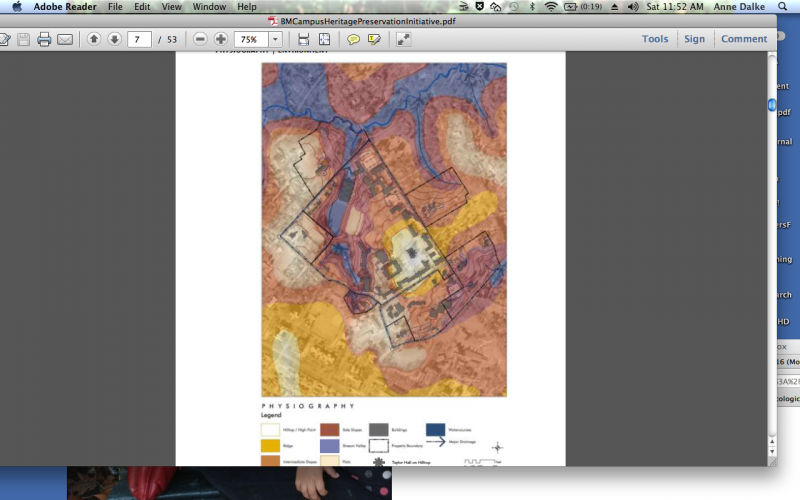Serendip is an independent site partnering with faculty at multiple colleges and universities around the world. Happy exploring!
Blogs

Some leads/threads/possibilities for posting on Sunday...
 Consider some possibilities for a (water-y!) field trip:
Consider some possibilities for a (water-y!) field trip:
Mill Creek (see map, above, of BMC physiography, from the BMC Campus Heritage Preservation Initiative)
Dove Lake
Pennypack Park and Environmental Center (named after the Lenape word for deep, slow moving water)
John Heinz National Wildlife Refuge @ Tinicum (established to protect the last 200 acres of freshwater tidal marsh in Pennsylvania; from Lenape word "tennicunk" meaning "island" or "along the edge of the island")
Fairmount Water Works Interpretive Center, which tells the story of the Schuylkill River and the urban watershed; the Lenape called it Ganshohawanee, meaning "rushing and roaring waters," or "Manaiunk"; it was later given the Dutch name Schuylkill-- "hideout creek"? "hidden river?" referencing the river's (nearly hidden) confluence with the Delaware?
Why would we go on a field trip? What are we seeking to find/see/learn?

Giving a "tour" of Bryn Mawr
As you go about your week, take a photo or two that you would like to share with the women @ the Cannery, so they can have a "tour" of Bryn Mawr. Please post your photos here by Wednesday at 5:00, so Barb can compile them into a form that we can use in class. To keep things manageable, we suggest one or two photos per person (it can be more, if not everyone submits a photo). We hope some of you are interested in taking up this idea!

Web Paper Event # 2
Hira Ismail
November 5, 2012
Web Paper Event # 2
Class Proposal
In my initial Thoreauvian walk, what I concentrated on was my walk amongst the trees, and my varying reactions to the trees at night versus in the day. This time, I ended up concentrating on something that has been tugging at the back of my mind, which made me wonder about its presence on the rest of the campus. While doing my site-sits throughout this semester, I’ve been noticing how much waste has been left around the area of Rhoads Pond. This made me wonder how often people actually do visit the pond, not just to look at it from afar, but to explore and walk along the edges. There are wine bottles and plastic bags and forgotten balls. I’ve seen cigarette packs and many other various items strewn around the bridge, and some have made their way into the water itself. My proposal for a class session then would be to have our entire class go to Rhoads Pond in order to clean up the area. Throughout the class, we have explored ways in which to represent our environment, in order to influence our community to help restore it. I think it would be useful to participate in restoration ourselves. The site-sits have been designed with the idea that we as students should really know and understand our campus before we graduate and lose the chance. Having a class in which we clean and leave the grounds on which our campus lies healthy would be the natural next step.

Ecolit Paper: Attending to the Past in Order to Face the Present
Do we really know our ecological past? Do we really understand our present? These questions seem to be intertwined in significant ways; our construction of the past also lends itself to the construction of the present. Is part of the key then to facing current dilemmas confronting the history of the land? I decided to explore some of these more ecological questions by reassessing my own interactions with the environment I live today- Bryn Mawr College. I was interested in finding out whether knowing more about the history of a particular space changed how I interacted with it in the future. In particular, I was interested in the history of maids who lived in the dorms and served the undergraduate students. However as I searched for information, my interest broadened to include Bryn Mawr’s entire racial history, especially the history of Perry House, one of dorms on campus that is important both as a space for a multicultural community and as a piece of Bryn Mawr’s racial history.
Voting: Bryn Mawr Style
 I found this image online and thought how appropriate! A strong Bryn Mawr female telling us to vote.
I found this image online and thought how appropriate! A strong Bryn Mawr female telling us to vote.
And then some radical feminist part of me thought: "She is telling us to vote, to play along with the male created systems! And she's holding a gun! How violent and male!"
And then I laughed at myself.
Hurricane Ramblings
http://www.theonion.com/articles/nation-suddenly-realizes-this-just-going-to-be-a-t,30195/
I enjoy reading The Onion, and I just thought this was a great way of looking at the aftermath of Hurricane Sandy. I hope they are right and that people are starting to realize there is something wrong with the environment now. I feel like denial about global warming is just an excuse to ignore regulations from the EPA. Personally, politicians who bash the EPA annoy me. They say these regulations constrain business, but if we bring the world down, then we (and those businesses)are going down with it (not to be too tragic).

Hurricane Plus Nor'Easter Equals?
Nantucket Island never lost electricity,
Though winds swept sand into my eyes and the sea spewed.
It wasn’t the perfect storm, Hurricane Sandy.
Murray’s Liquor was last Main Street store to close surely;
The pharmacy counter got tipped twenty for food.
Nantucket Island never lost electricity
Sand bagging the strip was proven unnecessary;
Below the sidewalks well-behaved floodwaters brewed.
It wasn’t the perfect storm, Hurricane Sandy.
Brussels sprout stalk in the fireplace were pretty smelly,
But my best friend insisted firewood should be valued!
Nantucket Island never lost electricity!
A cottage in Madaket was swept into the sea;
Residents weren’t surprised, the owners subdued.
It wasn’t the perfect storm, Hurricane Sandy.
Posting flood photographs on Facebook makes New Jersey
Friends worry about me, while waiting to be rescued.
Nantucket Island never lost electricity;
It wasn’t the perfect storm, Hurricane Sandy.

Radical Garden: Weeds and Wildflowers
“Creation of a society without dominance”
On October 3, I found that an area of my site had been sectioned off from the rest. On the hill behind Arnecliffe, there were little yellow flags, a thin yellow border sprayed on the grass around the space. And inside, the grass was either dead or dying. This was very upsetting. What could possibly be the cause of this removal, this mass extinction?


(note: Ed Harman is the Assistant Director of Grounds at Bryn Mawr)

Observations and Tracking Wind
Last week, I was so proud of my shiny new spot with the bright leaves in warm colors. This week, it looks absolutely nothing like it did.
The tree that had provided me with a spectrum of warm colors and a little autumn paradise has moved from shedding its leaves to shedding entire boughs and branches and ironically limiting my mobility in a spot I chose in order to increase it. At first I was disappointed (although not entirely surprised) by the extreme changes, but the storm, as it turns out, didn't ruin my nature observations forever.
Last week, my observation was about the diversity of leaves that I initially overlooked and the difference between my initial perception of them and the way they appeared to me upon closer examination. Honestly, I now wish I had saved that topic for this week as Sandy has brought me a huge range of not only different colors but different leaves, needles, acorns or pinecones, entire branches, and displaced vines that probably have no business being there or anywhere nearby, but make my spot full of a lot more interesting things to discover. Looking beyond the one primary tree to the ones nearby, I can identify a lot of the new additions as parts of those, but some are strangely nowhere to be found. This implies that some of the leaves (and one branch or part of a bush) was blown into my spot from some places that are nowhere in the general vicinity of the Erdman circle. The strength of wind that this suggests is both worrisome and fascinating.


